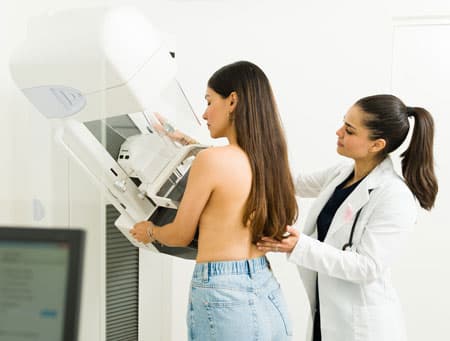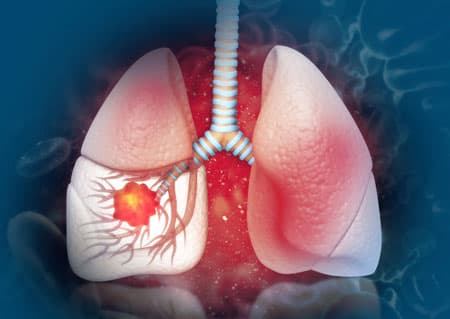Screening for Cancer
The American Cancer Society recommends routine screening for several common cancers, including breast, colorectal, cervical, prostate, and lung cancers.
Cancer screening tests may include blood tests, physical exams, screening mammograms, Pap smears, stool samples, colonoscopies, and CT scans.
Early detection and treatment are crucial to cancer survival. Routine screenings are intended to identify cancer at an early stage when less aggressive treatments have a greater chance of success. The decision about which screening tests are appropriate for you and how often you should be screened is best made by you and your healthcare provider.
What Cancers can be screened for?
 Breast Cancer
Breast Cancer
- Annual mammogram screening is recommended to start at age 40 for average risk women and should continue age 45 to 54. (an x-ray of the breasts).
- Women aged 45 to 54 should receive yearly mammograms.
- Women 55 and older, it is recommended every year also.
Women should be familiar with how their breasts normally look and feel. Any change should be reported to a healthcare provider right away.
Some women – due to their family history, a predisposition, or specific risk factors – should undergo MRI scans along with their mammograms.
Talk to your healthcare provider about your breast cancer risks and the appropriate screening test and schedule that is right for you.
Visit San Antonio Regional Hospital's Women's Breast and Imaging Center for all your breast health needs. The Women's Breast and Imaging Center features the latest radiographic technology, including:
- Digital Breast Tomosynthesis: 3D mammography produces images that can be manipulated and compressed into High Definition (HD) images, allowing for greater detail. This process enables the radiologist to see subtle changes which may be associated with an early sign of breast cancer.
- Breast Ultrasound is a valuable non-invasive tool. Breast ultrasound is often used to examine an area of concern seen in mammography and is particularly helpful for women with dense breast tissue.
- MRI: Magnetic resonance imaging (MRI) uses magnetic fields and radio waves to create detailed pictures of internal organs and structures within the body. This test can help detect abnormalities before they become visible on other types of scans.
San Antonio Regional Hospital believes strongly in women's health and provides screening and diagnostic services at low or no cost to those who qualify for assistance. Click here to see if you qualify.
Cervical Cancer
- Human Papillomavirus (HPV) is the leading cause of cervical cancer. The CDC recommends that girls and boys be vaccinated against HPV when they're between the ages of 11 and 12 years old. While the vaccine is most effective when given before the onset of sexual activity, it remains beneficial if administered before age 26. The earlier the vaccination, the better, as per recommendations.
- Women between the ages of 21 to 29 should have a Pap test to look for abnormal cells or cervical cancer every three years.
- Women between the ages of 30 and 65 should have a Pap test every three years or an HPV test every five years, or a combination Pap/HPV test every five years.
- Screening for cervical cancer is not recommended for women younger than 21 or older than 65. However, your individual risk factors should be discussed with your physician so that they can determine the best screening schedule for you.
Ovarian Cancer
There are no recommended screening tests for ovarian cancer for women who do not have symptoms and are not at high risk of developing ovarian cancer.
- Routine pelvic exams may help your doctor recognize changes in the anatomy of your ovaries.
- For women at high risk for ovarian cancer, a transvaginal ultrasound may be used to take a closer look at the ovaries.
- CA-125 blood test may be performed to detect an elevation in the CA-125 protein. Increased levels of CA-125 protein are seen in women with ovarian cancer; however, this protein may be elevated due to other non-cancerous reasons, leading to a false positive result. For this reason, it is not used for routine screening.
Discuss your risks with your gynecologist to determine what screening tests would benefit you.
Prostate Cancer
- Prostate Specific Antigen (PSA): For men aged 55 to 69, deciding whether to get screened for prostate cancer with a PSA test is an important decision. PSA is a substance produced by the prostate gland. Levels of PSA in the blood can be higher in men with prostate cancer. However, a PSA level does not necessarily indicate that you have cancer. These levels may be elevated in other conditions that affect the prostate gland leading to a false positive result. The potential benefits of a PSA exam should be discussed with your physician.
Colorectal Cancer
Adults aged between 45 and 75 years old should be screened for colorectal cancer. The decision to be screened between ages 76 and 85 should be made with your doctor based on your individual risk factors.
These recommendations are for people at average risk of colorectal cancer:
Stool tests
- The guaiac-based fecal occult blood test (gFOBT) uses the chemical guaiac to detect blood in the stool. Recommended once a year.
- The fecal immunochemical test (FIT) uses antibodies to detect blood in the stool. Recommended once a year.
- A sigmoidoscopy examines the lower colon and rectum and is recommended every five or ten years, combined with a yearly FIT test.
- A colonoscopy examines the entire colon and rectum and is recommended every ten years.
- Computed tomography (CT) colonography, also called a virtual colonoscopy, uses X-rays and computers to produce images of the entire colon and is recommended every five years.
- People at high risk for developing colon cancer, including those with a first-degree relative with colon cancer before age 60, those with Inflammatory Bowel Disease, Ulcerative Colitis, or a positive genetic mutation, and those with polyps or adenomas should discuss their individual screening recommendation with their physician.
- The FIT-DNA test combines the FIT with a test that detects altered DNA in the stool. Recommended once every three years.

Lung Cancer
Low-dose computed tomography (LDCT) scans are the only recommended screening tests for lung cancer. LDCT is recommended for people without symptoms but at high risk of developing lung cancer. High risk is defined as:
- Men or Women between 50 and 80 years old and
- Have a 20-pack-year history or more (A pack-year is smoking an average of one pack of cigarettes per day for one year. For example, a person could have a 20-pack-year history by smoking one pack a day for 20 years or two packs a day for ten years) and
- Who currently smoke or have quit smoking within the last 15 years
Skin cancer
There are no official recommendations for or against skin cancer screenings. Skin cancers are increasing at an alarming rate in the US and are often one of the most preventable types of cancer.
Those at high risk should consider yearly skin surveillance by a dermatologist. For those at average risk, report any unusual moles or changes in your skin to your healthcare provider immediately.
Not all cancers have available screening tests.
If you notice any changes or unusual symptoms that worry you, consult your healthcare provider immediately.
